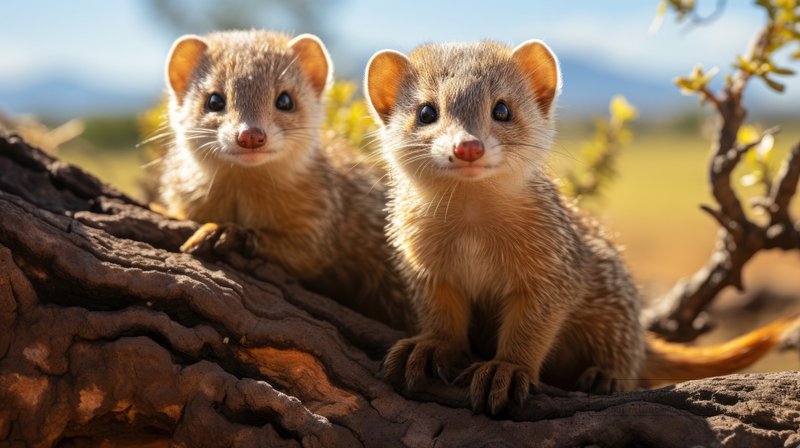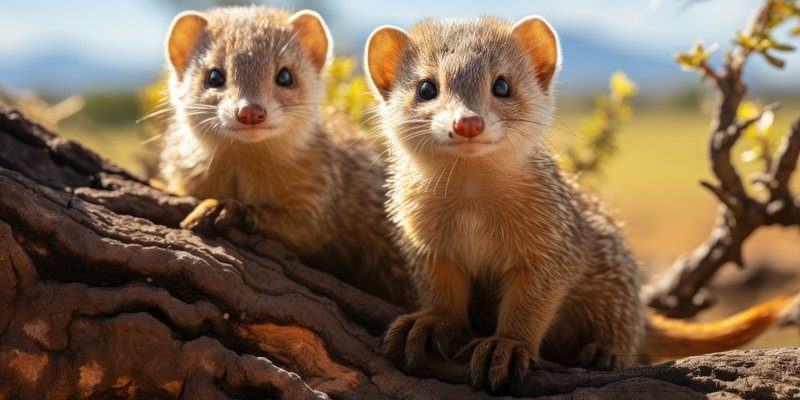
Mongoses belong to the family Herpestidae, which is part of the larger group known as carnivores. Over millions of years, they have developed unique traits that help them thrive in various environments. Whether they’re hunting down prey or evading predators, mongooses are a testament to nature’s incredible engineering. Let’s dive into their evolutionary story and see how these remarkable creatures got to where they are today.
Early Ancestors of the Mongoose
Mongooses have a fascinating lineage that traces back to their early ancestors, which lived millions of years ago. These ancestors are believed to have diverged from other carnivorous mammals around 35 million years ago. To put it simply, if we think of the animal kingdom as a huge family gathering, mongooses are the cousins that went on a completely different adventure than the rest of the carnivores, branching off and evolving into their own unique group.
The earliest mongooses were likely small, weasel-like animals that scavenged for food. Over time, they adapted to different habitats across Africa and parts of Asia. You might be wondering why adaptation matters. Well, it’s all about survival. As environmental conditions changed, these early mongooses developed traits that suited them best, like keen eyesight for spotting prey and enhanced agility for chasing after it.
Species Differentiation and Adaptation
As mongooses spread across various regions, they began to evolve into many distinct species. This process is similar to how an artist might create multiple versions of a painting, each with its own style and flair. Mongooses adapted to different food sources, climates, and habitats, leading to a variety of species that all share core similarities but also flaunt their unique characteristics.
For instance, the Egyptian mongoose is known for its social behavior, often living in groups and hunting together. In contrast, the black-tailed mongoose is more solitary, hunting alone and relying on stealth. These adaptations are not just fascinating quirks; they play a vital role in their survival. Whether working as a team or flying solo, each species has carved out a niche in diverse ecosystems.
Physical Traits of Mongooses
One of the most captivating parts of the evolutionary history of mongooses is their physical traits. These animals are built for speed and agility, with slender bodies and powerful limbs. Their sharp claws help them dig into burrows or grip onto prey. Picture them as the acrobats of the animal world, twisting and turning to catch their next meal.
The mongoose’s fur is also something to note. Many species boast a sleek coat that helps them blend into their surroundings, aiding in both hunting and evading larger predators. Some mongooses even exhibit remarkable color variations that can indicate different species. This isn’t just for show; it’s another part of their survival strategy, allowing them to adapt to various climates, from the dry savannas to lush forests.
Social Behavior and Survival Strategies
The social behavior of mongooses is another fascinating aspect of their evolutionary story. While some species prefer solitude, others have developed complex social structures. For example, the meerkat, a famous member of the mongoose family, lives in large groups and exhibits highly organized behavior, including babysitting roles and lookout duties. This social structure allows them to defend against predators and raise their young more effectively.
You might find it interesting to note how these social behaviors have evolved. In habitats where predators are abundant, being part of a group can significantly increase the chances of survival. It’s much like a group of friends supporting each other in tough situations—safety in numbers! This concept has shaped the way mongooses interact and survive in their environments.
Mongooses and Their Role in the Ecosystem
Mongooses play a crucial role in their ecosystems, acting as both predators and prey. They help control populations of pests like insects and rodents, contributing to a balanced environment. Imagine a natural team of exterminators, keeping rodent populations in check and ensuring that ecosystems function smoothly.
However, their role isn’t just about control. Mongooses also serve as food for larger animals, such as birds of prey and snakes. This creates an intricate web of life where each creature, including the mongoose, has a vital part to play. By understanding their role, we can appreciate the importance of biodiversity and the interconnectedness of life on our planet.
Mongooses and Human Interaction
With their intriguing behaviors and adaptability, mongooses have crossed paths with humans in various ways. In some cultures, they are celebrated for their pest-control abilities, especially when it comes to dealing with snakes. Their reputation as fearless snake fighters is well-known, but this isn’t always a straightforward relationship.
On the flip side, mongooses can sometimes be viewed as pests themselves. In regions where they’ve been introduced, such as Hawaii, they can threaten local wildlife, leading to significant ecological challenges. It’s crucial to consider these interactions and what they reveal about how we manage species in our environments.
The Future of Mongooses
As we look toward the future, mongooses face various challenges. Habitat destruction, climate change, and human encroachment are real threats to their populations. Conservation efforts are vital to ensuring these remarkable animals continue to thrive and adapt. It’s a bit like guarding a treasure trove of history; we must protect their habitats so that future generations can appreciate their unique evolutionary journey.
Efforts to study and conserve mongooses are also essential for understanding broader ecosystem health. By keeping tabs on their populations and behaviors, researchers can gain valuable insights into environmental changes that could impact many species, including humans.
The evolutionary history of the mongoose is a fascinating tale of adaptation and survival. From their early ancestors to their modern-day relatives, mongooses showcase nature’s ability to innovate and overcome challenges. We’ve learned that they’re not just fierce hunters; they’re also vital players in their ecosystems, contributing to a delicate balance of life.
As we continue to explore and understand these incredible creatures, let’s remember the importance of protecting their habitats and ensuring their survival for generations to come. After all, the story of the mongoose is a reminder that every creature, no matter how small, plays a significant role in the grand tapestry of life on Earth.

